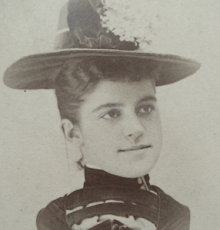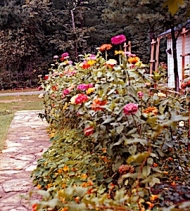Long before I knew Emilie Loring’s history, I was in love with Victoriana. I should explain what I mean about that.
I was raised in Arizona, a desert kid in a region known for brilliant color in its rocks, sunsets, and the Mexican decorating influences everywhere. This was my bedroom wallpaper. Don’t judge. I still love it.
I wasn’t a fussy kid. I climbed trees and caught crawdads from the irrigation ditch. My favorite books were mysteries and adventures. With my friends, I played army, cowgirl, and dog show.
Every summer, we went to visit my paternal grandparents in Wisconsin. It was entirely different there. Hot, desert colors gave way to the cool blues and greens of our lake and its surrounding pine trees. My grandmother’s gardens overflowed with lavender phlox, pink and yellow snapdragons, and every possible color of zinnia.
My grandma was born in the Victorian era and retained many of its customs. We awoke each morning to a multi-course breakfast: fresh citrus eaten with a grapefruit spoon, cereal and milk, eggs and bacon or sausage, and a finishing sweet, like cinnamon rolls or a Danish. Then out we would run, to swim or canoe until lunchtime.
Lunch was a simpler meal–sandwiches, fruit or pickles, and a cookie. But the sandwiches were unlike the peanut butter or bologna-and-cheese we had at home. Grandma served liverwurst, egg salad, and ham salad sandwiches cut into tiny quarters. Accompanying “pickles” might be pickled watermelon rind, cauliflower, or olives.
“…we as a family are addicted to sandwiches… an hour’s rest after luncheon””
For the Comfort of the Family: A Vacation Experiment
After lunch, we were required to lie down and rest. Of course, none of us wanted to sleep when we were eager to get back out onto the swimming float, so we read instead.
I read most of Emilie Loring’s books at my grandma’s house, and as I entered into those imagined worlds, our lake fused into the coast of Maine; Grandma’s old clocks, books, and china were the accoutrements of New England drawing rooms. There was some justification in that, as Grandma’s roots were as deep in New England as Emilie Loring’s.
 When Grandma gave bridge parties, she covered card tables with freshly-pressed linens, poured iced tea and lemonade, and set out crisp decks of playing cards. Her guests, with names like Blanche, Florence, and Edith, brought homemade bars and cookies–lemon, oatmeal-raisin, and butterscotch. Wearing dresses and little hats with net edgings, the ladies launched into serious card-playing punctuated by friendly laughter.
When Grandma gave bridge parties, she covered card tables with freshly-pressed linens, poured iced tea and lemonade, and set out crisp decks of playing cards. Her guests, with names like Blanche, Florence, and Edith, brought homemade bars and cookies–lemon, oatmeal-raisin, and butterscotch. Wearing dresses and little hats with net edgings, the ladies launched into serious card-playing punctuated by friendly laughter.
The silver bowl … was flanked by crystal plates of paper-thin sandwiches. Others displayed one-bite iced cakes. A tall silver urn, a large silver hot-water kettle, were surrounded by gold-banded pink cups and saucers and the trimmings for coffee and tea. I Hear Adventure Calling
Ours was a two-bedroom cottage by a lake, but the niceties were the same that I read about in Emilie Loring’s books. I loved the sense of heritage, the unfussy attention to the pretty details of a congenial atmosphere, the pleasant manners and conversation.
Not long after I moved into my first house in Kansas, a new magazine named Victoria came out. It’s not the same as what you find on the newsstand now; the original version featured gorgeous photos by Toshi Otsuki and, despite a tendency toward “be-” prefixes (bedecked, beribboned), it was full of informative content about Victorian times. I saved every issue and pored over details of gardens and decorating.
In my second house, I put those ideas into operation. I grew roses in abundance, created garden paths and garden rooms, decorated with lace and family heirlooms, and cut fresh flowers for every room.

Emilie Loring’s stories were so clearly set in the twentieth-century that I never suspected their author had spent the formative years of her life in the Victorian era. Imagine my surprise and delight when I learned that she was born in 1866 and grew up in one of my favorite historical periods!
My daughter and I spontaneously broke into song the other day:
“Make new friends, but keep the old; one is silver and the other gold!”

Emilie Loring kept her Victorian sensibilities and welcomed the improvements of modern life.
I have a mother who is a twentieth century model in all ways, except her dislike of being out after dark without an escort. In that respect she is hopelessly mid-Victorian. Here Comes the Sun!
That’s no small feat. Retaining balance takes wisdom, and I count on her for that. It is one of the special charms–and true benefits–of reading her books.
“In spite of the difference in the beliefs of his generation he has always shown a courteous respect for and observance of the beliefs of mine.”
“That’s because in a secluded corner of your children’s twentieth century hearts you early planted and cultivated a garden of nineteenth century ideals,” Nancy acknowledged tenderly.
Gay Courage
A woman with a keen sense of values, a woman who in her conversation was pungent and distinctly modern. She was in love with life, that was evident.
We Ride the Gale!

















I love your blog as I love the stories of Emilie Loring.
I recently came across an article about the artist Manning deV Lee ,illustrator of many of Mrs Lorings’s dustjackets. You can find this under pulpartists.com under his name.
My question is how many of her books were illustrated by M deV Lee?
LikeLike
Hi, Patti! My grandmother had very little and my mom said she didn’t want her things because they were old, not new. I think they yearned to buy new things,
LikeLiked by 1 person
That’s a good reminder, that simply being old doesn’t make something dear. It’s when memories imbue them with meaning that we cherish them. And of course, there’s a sense of freedom in going toward the new!
LikeLiked by 1 person
What beautiful memories! I remember finding that first issue of Victoria magazine in an airport when flying to visit a close friend. I read it over and over, getting lost in it. I subscribed because I had to read every issue!
LikeLiked by 1 person
It was a great magazine. I confess that I still have every issue, except for the December ones, which, alas, were borrowed and not returned. When next I’m homebound for some reason, I should put a box of them by my chair and indulge!
LikeLike